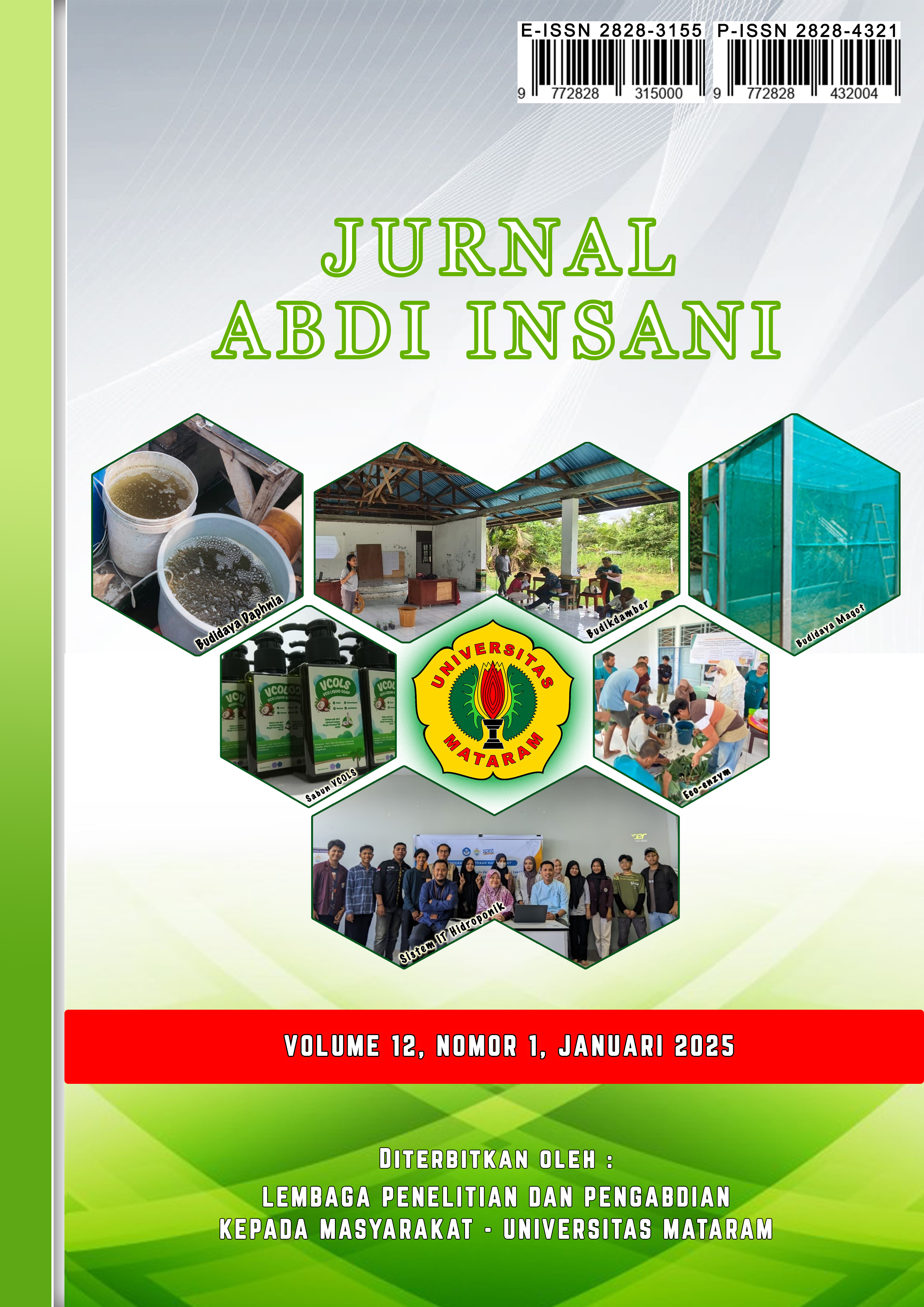EDUKASI MENGENAI FAKTA DAN MITOS EPILEPSI DI POLI SARAF RUMAH SAKIT UNIVERSITAS MATARAM
DOI:
https://doi.org/10.29303/abdiinsani.v12i1.1939Keywords:
Epilepsy, Seizures, Education, Myths, Stigma, Medication Adherence, Social SupportAbstract
Epileptic seizures have a significant negative impact on the lives of patients, especially those who frequently experience relapses due to low medication adherence. Epilepsy patients often face stigma and social discrimination. Misunderstandings and negative societal attitudes, influenced by myths surrounding epilepsy, can prevent patients from seeking treatment and living confidently. This community service activity aimed to provide information and education about epilepsy, covering topics from its definition to an in-depth discussion of myths and facts about the disease. The ultimate goal was to enhance the knowledge of patients, their families, and visitors at the neurology outpatient clinic of Mataram University Hospital. The activity was conducted through interactive counseling sessions using PowerPoint presentations. Participants completed a pre-test before the counseling session, followed by a question-and-answer discussion after the material was delivered, and concluded with a post-test. A total of 56 participants attended. Both pre-test and post-test consisted of five questions addressing basic knowledge about the definition of epilepsy, myths and facts, and appropriate actions when encountering an epileptic seizure. The average pre-test score was 68.57, while the average post-test score increased to 76.44 after the educational session and discussion. Effective communication, education, and information dissemination proved to be key solutions for improving participants' knowledge. These efforts are expected to help epilepsy patients avoid stigma, gain full support from family and their surroundings, ensure optimal treatment outcomes, and enable patients to live confidently. Effective education and communication are critical in improving understanding of epilepsy, reducing stigma, and fostering social support for epilepsy patients.
Downloads
References
Akokuwebe, M. E., Idemudia, E. S., & Onikanni, S. A. (2020). Social stigma and misconceptions about epilepsy: An overview of global perspectives. Epilepsy & Behavior, 103, 106506. https://doi.org/10.1016/j.yebeh.2020.106506
Anwar, M., et al. (2020). Epileptic seizure. PubMed Central, 8, 110.
Archana, V., Pathak, P., Mishra, A. K., & Upadhya, S. (2024). Factors linked with perceived stigma amid people with epilepsy: A cross-sectional study. Epilepsy Research. https://doi.org/10.1016/j.eplepsyres.2024.107428
Asadi-Pooya, A. A., Nikseresht, A., Yaghoubi, E., & Nejad, F. R. (2019). Stigma and its determinants among people with epilepsy: A systematic review. Seizure, 69, 13–18. https://doi.org/10.1016/j.seizure.2019.02.005
Bagheri, S., Khatoonabadi, A. R., & Soleimani, F. (2021). Family support and knowledge about epilepsy: A systematic review. Iranian Journal of Neurology, 20(1), 32–40. https://doi.org/10.4103/ijn.ijn_2021
Ciqing, Y., Shi, Y., Li, X., Guan, L., Li, H., & Lin, J. (2022). Cadherins and the pathogenesis of epilepsy. Cell Biochemistry and Function. https://doi.org/10.1002/cbf.3699
Darkhawasti, S., Gul, A., Bibi, A., Saleem, R., Khaliq, F., & Manzoor, U. (2024). Relationship between stigma, psychological flexibility, positive and negative affect in patients with epilepsy. Journal of Health and Rehabilitation Research. https://doi.org/10.61919/jhrr.v4i2.1055
Giourou, E., et al. (2015). Introduction to epilepsy and related brain disorders. In Cyberphysical Systems for Epilepsy and Related Brain Disorders (pp. 11–38).
Gordon, W. (2023). The pathogenesis of epilepsy. https://doi.org/10.54254/2753-8818/3/20220274
Iwayama, T., Mizuno, K., Yıldız, E., Lim, K. S., Yi, S. M., & Ong, J. C. Z. (2024). A multicultural comparative study of self‐stigma in epilepsy: Differences across four cultures. Epilepsia Open. https://doi.org/10.1002/epi4.13051
Kurniawan, D., et al. (2023). Epilepsi dalam pedoman praktik klinis neurologi. Perhimpunan Dokter Spesialis Saraf Indonesia, 1–8.
Makhado, T. G., Sepeng, N. V., & Makhado, L. (2024). A systematic review of the effectiveness of epilepsy education programs on knowledge, attitudes, and skills among primary school learners. Frontiers in Neurology. https://doi.org/10.3389/fneur.2024.1356920
Maulana, H. (2009). Promosi kesehatan. Jakarta: EGC.
McCagh, J. (2010). Epilepsy: Myths, stereotypes, and stigma.
Notoatmodjo, S. (2013). Pendidikan dan perilaku kesehatan. Jakarta: Rineka Cipta.
Ofhani, P. M., Makhado, L., & Maphula, A. (2024). Developing and validating an epilepsy awareness and education program: Bridging gaps in knowledge and support for people living with epilepsy and their families. Patient Preference and Adherence. https://doi.org/10.2147/ppa.s463151
Reilly, C., & Ballantine, R. (2011). Epilepsy in school-aged children: More than just seizures. Support for Learning. https://doi.org/10.1111/j.1467-9604.2011.01501.x
Stafstrom, C. E., & Carmant, L. (2015). Seizures and epilepsy: An overview for neuroscientists. Cold Spring Harbor Perspectives in Medicine.
Sumadewi, K. T., Harkitasari, S., & Tjandra, D. C. (2023). Biomolecular mechanisms of epileptic seizures and epilepsy: A review. Acta Epileptologica. https://doi.org/10.1186/s42494-023-00137-0
Takahashi, Y. (2006). Infections as causative factors of epilepsy. Future Neurology. https://doi.org/10.2217/14796708.1.3.291
Techilo, T., Shegaye, S., Medifu, G., Fentahun, S., & Getinet, W. (2024). Perceived and self-stigma in people with epilepsy in East Africa: Systematic review and meta-analysis. Seizure-European Journal of Epilepsy. https://doi.org/10.1016/j.seizure.2024.03.003
Thomas, V. S., et al. (2011). Confronting the stigma of epilepsy. PubMed Central, 13, 158–163.
Turan, F. D., & Yangöz, S. T. (2022). Effect of educational interventions on level of epilepsy knowledge in children with epilepsy and parents: Systematic review and meta-analysis. Journal of Clinical Nursing. https://doi.org/10.1111/jocn.16346
Weber, D., & Moeller, J. J. (2019). Epilepsy education: Recent advances and future directions. Current Neurology and Neuroscience Reports. https://doi.org/10.1007/s11910-019-0946-7
World Health Organization (WHO). 2022. Epilepsy: A public health imperative. Geneva: WHO. Retrieved from https://www.who.int/publications/i/item/epilepsy-a-public-health-imperative




















